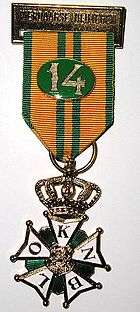Cross for the Four Day Marches
| Cross for Marching Proficiency Kruis Voor Betoonde Marsvaardigheid | |
|---|---|
|
Bronze cross, awarded for first successful march | |
| Awarded by The Royal Dutch League for Physical Education | |
| Country | The Netherlands |
| Type | Commemorative medal |
| Awarded for | Successful completion of the International Four Days Marches Nijmegen |
| Status | Currently awarded |
| Precedence | |
| Next (higher) | Order of the Golden Ark |
| Equivalent | Awards of Dutch NGO's |
| Next (lower) | Awards from international organizations |
|
Ribbon bar of the medal | |


The Cross for the Four Day Marches (Dutch: Vierdaagsekruis) is a Dutch decoration awarded for successful participation in the International Four Days Marches Nijmegen (Vierdaagse in Dutch) held annually at Nijmegen, Netherlands. The full title of the decoration is the Cross for Marching Proficiency (Kruis Voor Betoonde Marsvaardigheid). It is more commonly referred to as the Vierdaagse Cross or Vierdaagsekruis.
History
The cross was established in 1909 at the time of the first march, to award successful military participants of the Vierdaagse. Since 1910 it has been awarded to all participants who successfully complete all four days, both military and civilian.
The Cross is awarded by the Royal Dutch League for Physical Education (KNBLO or Koninklijke Nederlandsche Bond Voor Lichamelijke Opvoeding) who organise the Nijmegen Marches. Prior to 1959, when it received the Royal (Koninklijke) prefix, the League was known as the NBVLO.
As well as the Vierdaagse at Nijmegen, the cross was also awarded to those who completed the four day marches organised in various locations in the Dutch East Indies between 1935 and 1939.
Wear on military uniforms
Although it is awarded by a non-governmental organisation, the Cross has received Royal approval and can be worn on the uniforms of the Armed forces of the Netherlands and other Dutch uniformed services, including the police, fire brigade and customs services. It is therefore an official decoration of the Kingdom of the Netherlands.
This Royal recognition has extended over the years. Authority to wear in uniform was first granted in October 1909 to infantry soldiers below officer rank. Other soldiers could accept the decoration, but not wear it. As the March established itself, this authority widened with, for example, sailors of the Royal Netherlands Navy were granted permission to wear in 1919 and army and naval officers from 1928.
A number of other nations now permit the Vierdaagse cross to be worn in military uniform. These include: Denmark, France, Germany, Norway, Sweden (since 1977), and the USA. Those who do not allow the medal to be worn include Canada, Israel and the United Kingdom.
Design
The decoration is a five armed cross, with each arm bearing an initial of the awarding organisation. It has a width of 36 mm at its widest point and is suspended from a green and yellow (often orange-yellow) ribbon. Until 1958 the initials on the five arms read: ‘NBVLO’, with ‘KNBLO’ since 1959 to reflect the Koninklijke (Royal) prefix. There have been other minor changes in design over the years. For example, in 1977 the previous silver gilt and silver crosses were replaced by base metal versions, with other design modifications in order to reduce costs.
The reverse is plain except for the name of the manufacturer.
All medals were made by Koninklijke Begeer of the South Holland town of Voorschoten until 1976, when the contract moved to W. van Veluw of Zeist, near Utrecht.
Award Structure
Every year a walker successfully completes the march is marked either by a special cross, or a number to be attached to the ribbon of the last cross awarded. A cross is awarded in bronze for the first march, silver for the fifth and gold for the tenth, with a crown added above the cross for the year after each cross is awarded. Appropriate numbers are pinned on the ribbon for intervening years. In recent years further distinct crosses, with crown, have been added for a walker’s fortieth, fiftieth and sixtieth successful march. To date the highest ribbon number awarded is 69 to Bert van der Lans in 2016.[1]
Only one cross, the last to be awarded, is worn. For ribbon numbers, only the number most recently received should be worn.
Numbers awarded
Between 1909 and 2016, about 612,500 walkers successfully completed the march 1,574,173 times. Therefore, approximately 612,500 first year crosses have been awarded, (including about 257,000 since 1990), with over 960,000 further awards, including second year crowns, silver and gold crosses and ribbon numbers. Of the awards for the highest number of marches, approximately 662 walkers have been awarded the cross for forty years, about 143 for fifty years and ten for sixty years.
See also
References
- H.G. Meijer, C.P. Mulder en B.W. Wagenaar, "Orders and Decorations of the Netherlands", 1984
- H.G. Meijer en B.W. Wagenaar, "Onderscheidingen, Eretekens en Sportprijzen voor Vaardigheid", 2000
- M.A.A. Schakel, “De Wereld Wandelt”, KNBLO, 1991
- 1951 – 2001 50 Jaar Vereniging Gouden Kruisdragers Vierdaagse, KNBLO, 1993
- W.F. Bax, "Ridderorden, eereteekenen, draagteekens en penningen, betreffende de Weermacht van Nederland en Koloniën (1813-heden)", 1973
External links
Also a note on the medal on the official Vierdaagse site: http://www.4daagse.nl/nl/evenement/vierdaagsekruis.html
